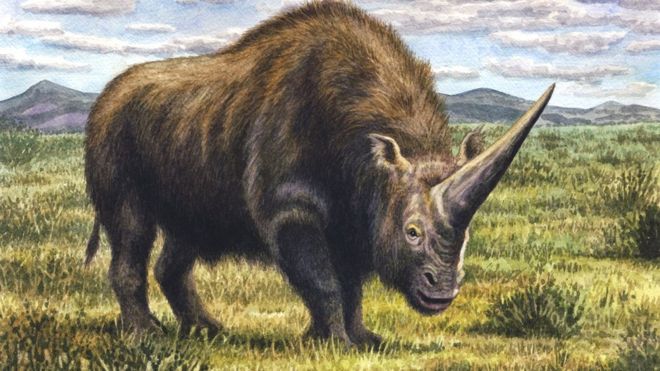Post by dinosauria101 on Jul 2, 2019 9:01:44 GMT 5
Elasmotherium sibiricum
Elasmotherium ("thin plate beast") is an extinct genus of large rhinoceros endemic to Eurasia during the Late Pliocene through the Pleistocene, existing from 2.6 Ma to at least as late as 39,000 years ago in the Late Pleistocene. E. sibiricum, was the size of a mammoth and is thought to have borne a large, thick horn on its forehead. Theories about the function of this horn include defence, attracting mates, driving away competitors, sweeping snow from the grass in winter and digging for water and plant roots. Like all rhinoceroses, elasmotheres were herbivorous. Unlike any others, its high-crowned molars were ever-growing. Its legs were longer than those of other rhinos and were adapted for galloping, giving it a horse-like gait. The known specimens of E. sibiricum reach up to 4.5 m (15 ft) in body length with shoulder heights over 2 m (6 ft 7 in). Elasmotherium weighed 4.5-5 ton.

Megatherium americanum
Megatherium ("Great Beast") was a genus of elephant-sized ground sloths endemic to Central America and South America that lived from the Pliocene through Pleistocene existing approximately 5.3 million years. Its size was exceeded by only a few other land mammals, including mammoths and the even larger Paraceratherium. Megatherium was one of the largest mammals known, weighing up to eight tons, about as much as an African bull elephant. Although it was primarily a quadruped, its footprints show that it was capable of assuming a bipedal stance. Megatherium is one of the largest land mammals known to have existed, weighing up to 4 tonnes and measuring up to 6 m (20 ft) in length from head to tail.. This sloth, like a modern anteater, walked on the sides of its feet because its claws prevented it from putting them flat on the ground. Megatherium species were members of the abundant Pleistocene megafauna, large mammals that lived during the Pleistocene epoch. Megatherium had a robust skeleton with a large pelvic girdle and a broad muscular tail. Its large size enabled it to feed at heights unreachable by other contemporary herbivores. Rising on its powerful hind legs and using its tail to form a tripod, Megatherium could support its massive body weight while using the curved claws on its long forelegs to pull down branches with the choicest leaves. Its jaw is believed to have housed a long tongue, which it would then use to pull leaves into its mouth, similar to the modern tree sloth.

Credit to Wikipedia
Elasmotherium ("thin plate beast") is an extinct genus of large rhinoceros endemic to Eurasia during the Late Pliocene through the Pleistocene, existing from 2.6 Ma to at least as late as 39,000 years ago in the Late Pleistocene. E. sibiricum, was the size of a mammoth and is thought to have borne a large, thick horn on its forehead. Theories about the function of this horn include defence, attracting mates, driving away competitors, sweeping snow from the grass in winter and digging for water and plant roots. Like all rhinoceroses, elasmotheres were herbivorous. Unlike any others, its high-crowned molars were ever-growing. Its legs were longer than those of other rhinos and were adapted for galloping, giving it a horse-like gait. The known specimens of E. sibiricum reach up to 4.5 m (15 ft) in body length with shoulder heights over 2 m (6 ft 7 in). Elasmotherium weighed 4.5-5 ton.

Megatherium americanum
Megatherium ("Great Beast") was a genus of elephant-sized ground sloths endemic to Central America and South America that lived from the Pliocene through Pleistocene existing approximately 5.3 million years. Its size was exceeded by only a few other land mammals, including mammoths and the even larger Paraceratherium. Megatherium was one of the largest mammals known, weighing up to eight tons, about as much as an African bull elephant. Although it was primarily a quadruped, its footprints show that it was capable of assuming a bipedal stance. Megatherium is one of the largest land mammals known to have existed, weighing up to 4 tonnes and measuring up to 6 m (20 ft) in length from head to tail.. This sloth, like a modern anteater, walked on the sides of its feet because its claws prevented it from putting them flat on the ground. Megatherium species were members of the abundant Pleistocene megafauna, large mammals that lived during the Pleistocene epoch. Megatherium had a robust skeleton with a large pelvic girdle and a broad muscular tail. Its large size enabled it to feed at heights unreachable by other contemporary herbivores. Rising on its powerful hind legs and using its tail to form a tripod, Megatherium could support its massive body weight while using the curved claws on its long forelegs to pull down branches with the choicest leaves. Its jaw is believed to have housed a long tongue, which it would then use to pull leaves into its mouth, similar to the modern tree sloth.

Credit to Wikipedia










